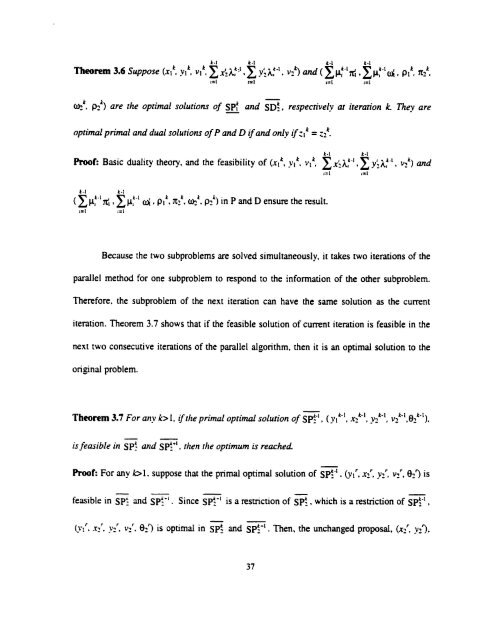X - UWSpace - University of Waterloo
X - UWSpace - University of Waterloo
X - UWSpace - University of Waterloo
You also want an ePaper? Increase the reach of your titles
YUMPU automatically turns print PDFs into web optimized ePapers that Google loves.
. -<br />
Thmm 3.6 Suppose (-ri. )Jik, VI', & ~ ) c ~ ' yi)Ci-l, ~ . ~ v23 and (zp:-ld ,Epf-lo;,<br />
-<br />
ct$. pt) are the optimal solutions <strong>of</strong> spf and SD;, respectively or ireration k They are<br />
-<br />
optimal prima1 and duo2 solutions <strong>of</strong> P and D if and only ifrik = zt.<br />
k & &<br />
4 -1 k-1<br />
hl: Basic duality theory. and the feasibility <strong>of</strong> . y . vl , xih,L-lv $h:-l, Y:) and<br />
r=l i=1<br />
(x k-1 L -1<br />
k k<br />
$'fi , pf*' O;, pi .I? . u)?~. p:) in P and D ensure the result.<br />
Because the two subproblems are solved simultaneously. it takes two itentions <strong>of</strong> the<br />
panllel method for one subproblem to respond to the information <strong>of</strong> the other subproblem.<br />
Therefore. the subproblem <strong>of</strong> the next iteration cm have the sarne solution as the current<br />
iteration. Theorem 3.7 shows that if the feasible solution <strong>of</strong> current iteration is feasible in the<br />
next two consecutive iterations <strong>of</strong> the parallel aigorithm. then it is an optimal solution to the<br />
orignal problem.<br />
- - 1 k-1 k-1 k-1<br />
Theorem 3.7 For k> 1. if the prima1 optimal solution <strong>of</strong> SPI.' , ( y 1 , x? . y2 , VI ,et1).<br />
-<br />
RooE For any b1. suppose that the primai optimal solution <strong>of</strong> spf". (yl: .d y2: utr, Oz') is<br />
- -<br />
(vif. x{, vt: is optimal in SP!_ and SP?*' . Then. the unchanged proposal. (xZr, yz'),
















